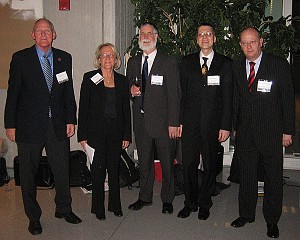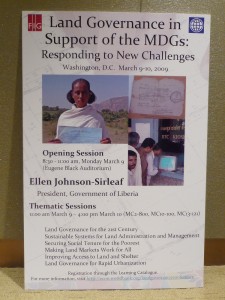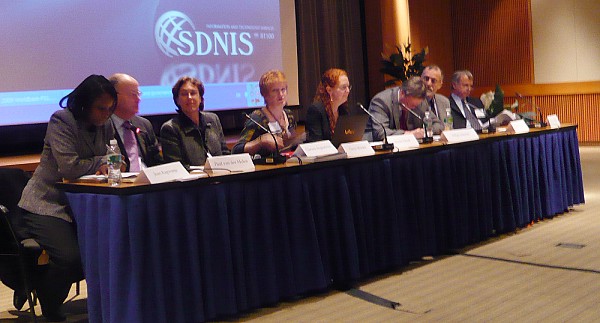
FIG/ World Bank Conference “Land Governance in Support of
the Millennium Development Goals: Responding to New Challenges”
Washington DC, USA 9-10 March 2009
|

FIG President
Stig Enemark, Inga Björk-Klevby (Deputy
Executive Director, UN-HABITAT, Mark Crackler, Director, WB
ARD, Klaus Deininger, WB and Paul van der Molen, FIG. |

Conference poster. |
The FIG - WB Conference "Land Governance in Support of the Millennium
Development Goals: Responding to New Challenges" took place at the World
Bank Headquarters in Washington DC, 9-10 March 2009. The conference was
organised by the International Federation of Surveyors and the World Bank.
The general aim was to emphasise the important role of Land Governance in
implementing the Millennium Development Goals (MDGs) and to show how FIG and
the WB work in parallel in this regard.
The Conference was attended by about 200 invited international experts
representing governments, UN agencies, development agencies, professionals,
academia and private sector.
The conference was divided on six themes:
- Land governance for the 21st century
- Building sustainable, well-governed land administration systems
- Securing social tenure for the poorest
- Making land markets work for all
- Improving access to land and shelter
- Land governance for rapid urbanization
Together with opening and closing sessions, donators session and country
reports in total around 80 papers were presented in 20 sessions.
At the closing session of the conference Prof. Stig Enemark, FIG
President concluded that "land governance is a crucial issue in meeting the
MDGs and should be high on the global agenda. New challenges in relation to
this (climate change, food security, energy scarcity, natural disasters,
urban growth, environmental degradation) have to be met. This is only
possible in a multi disciplinary approach – which calls for partnership. It
can be observed that the technology tools as available today are far ahead
compared to legal and institutional tools. For application of sophisticated
technology tools a good partnership is needed. Capacity building and
learning is also most relevant and urgent. In the process of land
administration the continuum of land rights as developed by UN-HABITAT
provides a good basis since this approach is socially embedded. Finding
evidence on the ground remains a key issue, this is where the land
professionals come involved. This process is expensive – a better monitoring
of the money that is spent is most relevant. There are reasons to be
optimistic looking at the strong demand from the client countries to help
addressing Land Administration."
The main outcomes of the conference and a joint FIG/WB declaration will
be published shortly in the FIG publication series.
Proceedings are now available both on the
FIG web site and the
WB web site.
In the organising committee FIG was represented by President Stig Enemark
and Paul van der Molen. Leading from the World Bank was
Klaus Deininger, Lead Economist, World Bank Land Thematic Group.
The gold sponsors of the event were ESRI, Trimble, Dutch Kadaster and GTZ
and silver sponsors Leica Geomatics and ITC.
Read more:
|

Panel at the Closing Session:
Joan Kagwanja, Economic Affairs
Officer, UN-ECA, chair of the closing session (left), Paul van
der Molen, the Netherlands, Clarissa Augustinus,
UN-HABITAT, Cheryl Morden, IFAD, Jolyne Sanjak, MCC,
Helge Onsrud, Norway and Alain Durand-Lasserve, France
and Paul Munro-Faure, FAO. |
|


























